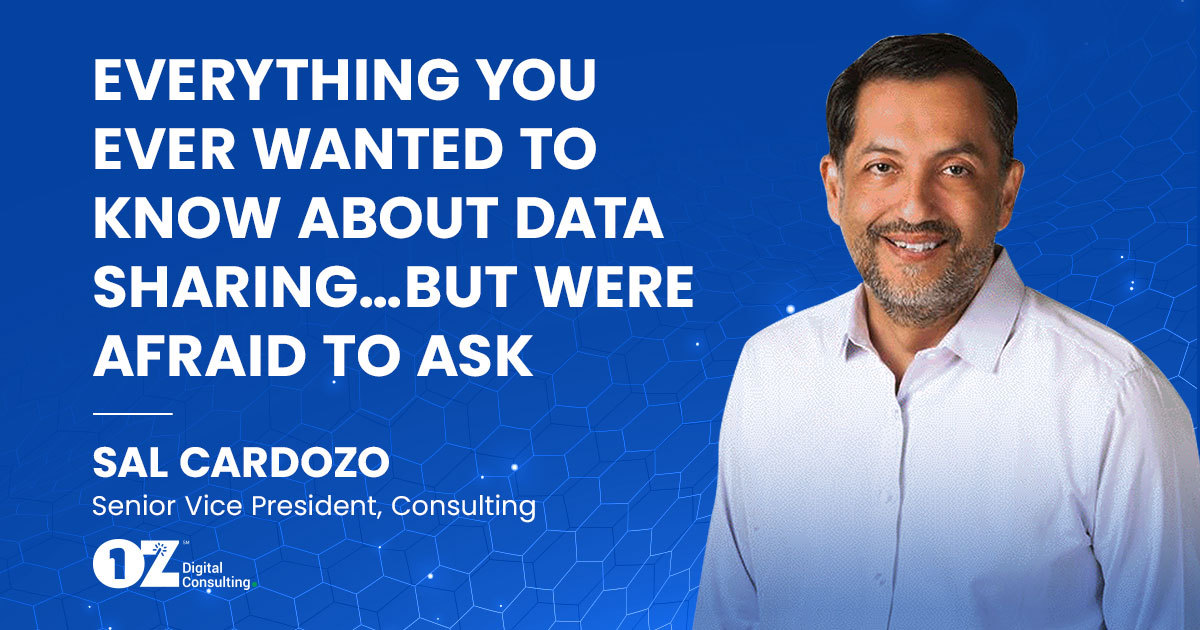Whether delivering data across the enterprise or augmenting internal data with broader market data to gain better insights, data sharing—once primarily the province of academic research—has become a highly prized and essential technology for businesses of all sizes.
So, what precisely is data sharing?
It is, in essence, the distribution of data sets among multiple users or applications—without sacrificing conformity across any of the parties using the data.
In today’s digital world, there are an incredible volume and array of data sources—from website visitor behavior to IoT device signals to vehicle onboard computers and beyond—and data sharing allows us to find order and opportunity in that vast maelstrom.
Data Sharing in The Cloud
Today, the cloud is expanding the scope of what is possible for data sharing.
This includes the ability to…
- …improve business efficiencies. Share live data with internal and external business partners to optimize spending, provide superior customer service, and streamline operations.
- …eliminate data silos. Create a single source of truth for all internal data and share it with multiple internal data consumers across many business units within a single organization.
- …data sharing as a product. Provide direct access to specific data sets as a monetized service for data consumers to augment their existing data.
- …data sharing as a product differentiator. SaaS providers can offer direct access to the petabytes of data generated from their B2B customer activity.
To fully leverage data sharing in the cloud, businesses will require a platform with speed, power, governance, security, and ease of use.
Data Sharing Use Cases
January 5, 2021.
The coronavirus genome sample is uploaded to the Internet, setting the stage for the world’s first batch of COVID-19 vaccines to be developed.
In the days, weeks, months, and years since coronavirus experts have exchanged public data sets in pursuit of more effective treatments and tests as well as mutation tracking processes.
This is just one example of how data sharing can drive urgently needed innovation.
Today’s economy revolves around data. More and more, organizations must exchange data with their customers, suppliers, and partners. Security, efficiency, and immediate accessibility are critical.
Gartner predicts that by 2023, organizations that promote data sharing will outperform their peers on most business value metrics.
Some common data-sharing use cases today are:
- Data monetization. Companies across industries are commercializing data, and this segment continues to grow across industries. Large multinational organizations have formed exclusively to monetize data, while other organizations are looking for ways to monetize their data and generate additional revenue streams. An example of this data is a home builder subsidiary capturing data online from potential home sellers and sharing with the new home marketing unit so they could do targeted marketing and obtain deeper market insights. Data vendors are growing in importance as companies realize they need external data for better decision-making.
- Data sharing with partners or suppliers (B2B). Many companies now attempt to share data with partners and suppliers much as they would share it across their own organizations. For example, transportation companies and their suppliers continue to work more closely together as they seek to minimize any impact on spare parts due to current supply chain challenges. They share engine and tire mileage data, so they know when to get replacement parts and prevent breakdowns.
- Internal sharing. Within any company, different departments, lines of business, and subsidiaries share data so that everyone can make decisions based on a complete view of the current business reality. Finance and manufacturing departments, for example, need to share data as they analyze the true costs of each employee. Marketing and sales teams need a common view of data as they seek to determine the effectiveness of marketing campaigns. And different subsidiaries of the same company need a unified view of the health of the business. Removing data silos—which are often established for the vital purpose of preventing unauthorized access to data—is critical for digital transformation initiatives and maximizing the business value of data
Key benefits of data sharing
The benefits an organization can derive from data sharing, as suggested above, are hardly insignificant.
To be a bit more specific, these include:
- The ability to generate new revenue streams. With data sharing, organizations can generate new revenue streams by offering data products or data services to their end consumers.
- Greater collaboration with existing partners. In today’s highly digital economy, successful enterprises are those that advance their business objectives through partnerships. Data sharing helps cement existing partnerships and establish new ones.
- Ease of producing new products, services, or business models. Product teams can leverage both first-party data and third-party data to refine their products and services and expand their product/service catalog.
- Greater efficiency of internal operations. Teams across the enterprise can meet their business goals far more quickly when they don’t have to spend time figuring out how to free data from silos. When teams have access to live data, there’s no lag time between the need for data and the connection with the appropriate data source.
Conclusion
Data sharing is an essential business capability—as well as an essential component of digital transformation.
It should be adopted as a program to accelerate access to advanced technologies and strategic data reuse while driving innovation and improved outcomes.



